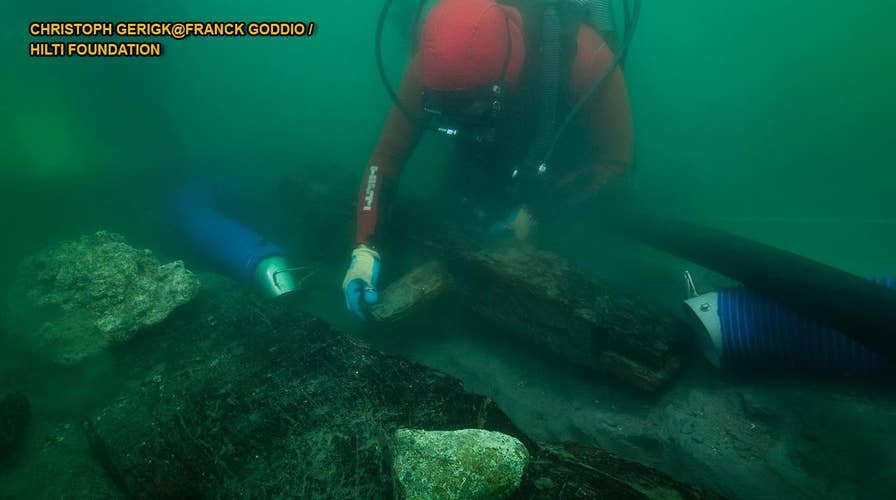Nile shipwreck from 500 BC helps solve ancient puzzle
An extremely rare vessel that traveled the Nile close to 2,500 years ago has been discovered in the sunken ancient port-city of Thonis Heracleion. The ship, known as a 'baris,' was first described by the Greek historian Herodotus, but until now there was no actual archaeological evidence of the boats. The baris would have been used to transport goods and may have also carried troops along the Nile.
Archaeologists in Egypt have discovered the wreck of an extremely rare vessel that traveled the Nile around 2,500 years ago, solving an ancient puzzle.
The barge is one of more than 70 wrecks found in what is described by experts from the European Institute for Underwater Archaeology (IEASM) as the world’s largest “graveyard of ancient ships.” The ships were discovered in the sunken ancient port-city of Thonis-Heracleion in the Nile Delta.
Known as a “baris,” the barge is the subject of a new book by Oxford University’s Centre for Maritime Archaeology (OCMA). “This was a particular vessel-type that was described by the Greek Historian Herodotus after he visited Egypt in 450 BC,” explains the Centre, in a statement.
AMAZING RAM-HEADED SPHINX LINKED TO KING TUT’S GRANDFATHER DISCOVERED IN EGYPT
However, prior to the discovery of the baris, which was dubbed "ship 17" by archaeologists, there was no actual archaeological evidence of the boats. As a result, historians have spent centuries arguing over Herodotus’ account of the vessels, according to the Guardian.

The wooden hull of ship 17. (Christoph Gerigk@Franck Goddio/Hilti Foundation)
The book “Ship 17 – a baris from Thonis-Heracleion,” by Alexander Belov, solves the mystery and analyzes the construction and structure of the boat, which is between 87 and 92 feet long. The boat dates to what historians refer to as the “Late Period” in ancient Egypt, which ran from around 712 to 332 B.C.
The baris would have been used to transport goods such as fish and stones along the Nile, according to LiveScience, which notes that it may have also carried troops.
TEENAGE GIRL’S SKELETON DISCOVERED IN MYSTERIOUS GRAVE NEAR EGYPTIAN PYRAMID
Belov’s research says that when no longer used as a trading boat, the barge likely became part of the port’s “maritime infrastructure.”

File photo - bust of Greek historian Herodotus at the Agora Archaeological Museum in Athens. (Photo by DeAgostini/Getty Images)
The OCMA is a partnership between the University of Oxford’s School of Archaeology and IEASM. Funded by the Hilti Foundation, the Centre is directed by maritime archaeologist Franck Goddio.
Egypt continues to reveal fresh details of its rich history. Archaeologists recently discovered a large ram-headed sphinx that is linked to King Tutankhamun’s grandfather.
KING TUT TOMB MYSTERY: EXPERTS EXPLAIN STRANGE SPOTS ON BURIAL CHAMBER'S WALLS
In other projects, a teenage girl’s skeleton was discovered in a mysterious grave near the Meidum pyramid, south of Cairo.

A rendering of ship 17. (Christoph Gerigk@Franck Goddio/Hilti Foundation)
Last month, experts announced the discovery of dozens of mummies in ancient desert burial chambers. Archaeologists also recently explained the strange brown spots on some of the paintings in King Tutankhamun’s tomb.
In January, archaeologists announced the discovery of ancient tombs in the Nile Delta north of Cairo. In a separate project, two ancient tombs dating back to the Roman period were uncovered in Egypt’s Western Desert.
'CURSED' ANCIENT EGYPTIAN SARCOPHAGUS REVEALS ITS GRISLY SECRETS
In November 2018, researchers confirmed the discovery of eight limestone sarcophagi containing mummies at a site 25 miles south of Cairo. Last year, researchers also uncovered a "massive" building that was once part of Egypt’s ancient capital city.
In another project, archaeologists discovered a stunning sphinx statue at an ancient temple in southern Egypt.
Last summer, experts unlocked the secrets of a mysterious ancient ‘cursed’ black granite sarcophagus. The massive coffin, which was excavated in the city of Alexandria, was found to contain three skeletons and gold sheets with the remains.
EIGHT ANCIENT PAINTED MUMMIES DISCOVERED IN EGYPT
Archaeologists also found the oldest solid cheese in the tomb of Ptahmes, mayor of the ancient city of Memphis.
CLICK HERE TO GET THE FOX NEWS APP
A mummy buried in southern Egypt more than 5,000 years ago has also revealed its grisly secrets, shedding new light on prehistoric embalming practices.
Fox News’ Chris Ciaccia and The Associated Press contributed to this article. Follow James Rogers on Twitter @jamesjrogers

